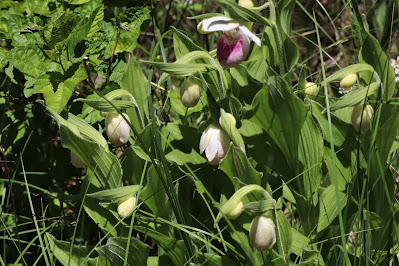No Wings, Just Orchids!
I have been fortunate to be in areas this spring where orchids can be found. Wild Orchids will almost never transplant successfully in a garden. They are heavily reliant on the soil and fungus environment where they first grew. They should only be enjoyed in their own habitats and left there to thrive. https://watershedmagazine.com/departments/orchids-in-the-wild/
Large Yellow Lady's Slipper
The Dragon's Mouth Orchid is typically found in acidic, boggy conditions including areas with Sphagnum mosses. Pollination is dependent on inexperienced bees that emerge throughout the blooming season because bees quickly learn to avoid these flowers that do not offer a reward of nectar!
https://goorchids.northamericanorchidcenter.org/species/arethusa/bulbosa/
The "Striped Coralroot" was a new orchid for me. This plant gets most of its food, not from photosynthesis, but through its relationship with Mycorrhizal Fungi. The fungus assists the plant roots in absorbing nutrients. https://goorchids.northamericanorchidcenter.org/species/corallorhiza/striata/
The uncommon "Showy Lady Slipper" can live for up to 50 years. It does not produce its own nectar and as a result is not visited by many pollinators. Luckily, one single flower can produce up to 35,000 very tiny orchid seeds. It can then take seven years for a seed to develop after it finds the appropriate soggy and shady conditions that they require. https://watershedmagazine.com/departments/orchids-in-the-wild/






No comments:
Post a Comment